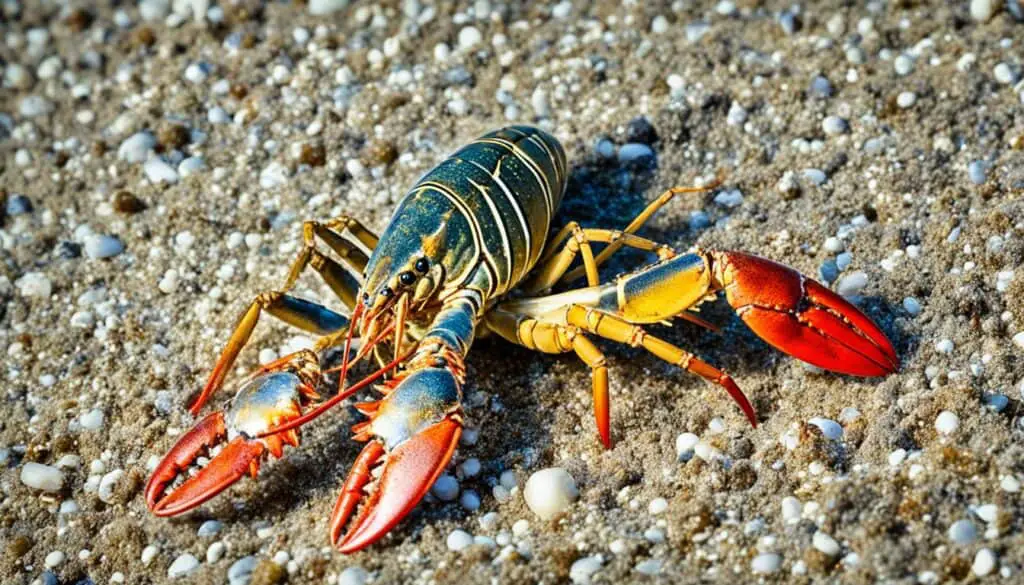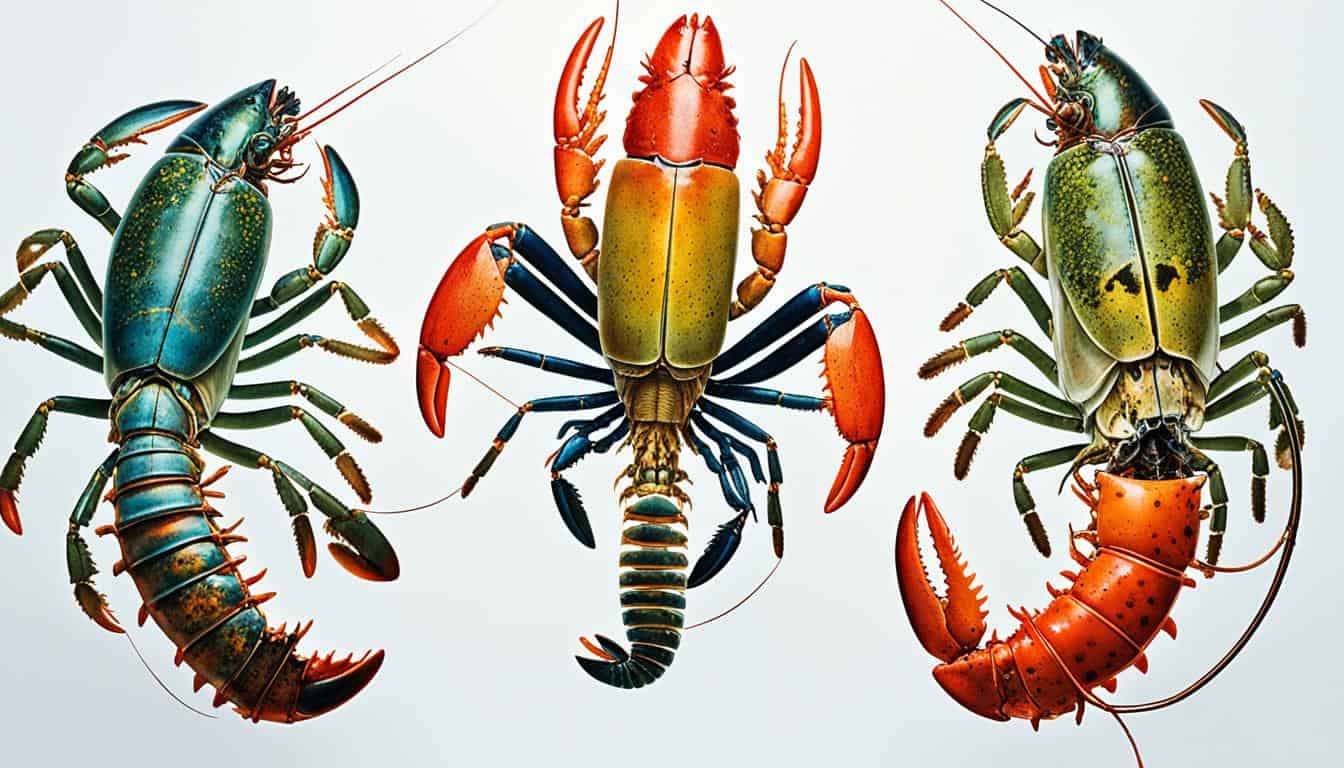Lobsters are fascinating crustaceans that capture our attention with their unique biology. They go through changes during their life cycle, which is crucial to understand. These changes include the need for a hard exoskeleton made of chitin. This outer shell doesn’t grow with them, so they shed it and grow a new one through a process called molting.
In this article, we will explore lobster development stages, the lobster molting process, and how hormones trigger this change. You’ll learn about the lobster’s growth and how they shed their shells to grow bigger.
An Overview of the Lobster Life Cycle
The lobster life cycle is full of fascinating stages. Female lobsters carry thousands of eggs, each ready to start a new journey. These eggs hatch into larvae that float near the ocean’s surface for weeks, changing into something new.
Lobster Development Stages
Larvae go through many molts, shedding their skin to grow. This is key for their survival. After these changes, they move to the seafloor, starting their growth journey.
During this time, they change a lot, moving through different stages of development.
Juvenile Lobster Growth
Juvenile lobsters grow fast, molting up to 25 times in the first few years. This helps them get ready for adulthood, which takes 5 to 8 years. Adults grow more slowly.
Males molt every year, while females molt every two years. This shows how they move through different stages slowly.
| Stage | Duration | Growth Characteristics |
|---|---|---|
| Egg | 1-2 months | Thousands of eggs produced by females. |
| Larval | Several weeks | Floating stage, multiple molts occur. |
| Post-larva | Variable | Seeks shelter, begins settling on the sea floor. |
| Juvenile | Up to 5 years | Rapid growth, multiple molts (up to 25). |
| Adult | 5-8 years | Slower growth, males molt annually, females every two years. |
The Anatomy of Lobsters: Understanding the Exoskeleton
Lobsters have a unique anatomy that helps them survive and grow. At the heart of this is the lobster exoskeleton, an outer shell. This shell protects them from predators and supports their body. Knowing about the outer and inner parts of a lobster is key to understanding how they live and shed their skin.
Outer and Internal Anatomy
The outer anatomy of lobsters has important parts that help them live well:
- Antennae: These help lobsters sense their surroundings.
- Carapace: This hard shell protects the thorax from harm.
- Claws: Lobsters use their claws to catch food and defend themselves.
On the inside, lobsters have a complex structure that supports their life:
- Digestive System: It breaks down food, absorbs nutrients, and gets rid of waste.
- Circulatory System: This system uses a copper-rich fluid called hemolymph.
Learning about the lobster exoskeleton and their anatomy shows how vital each part is. Every feature plays a big role in their everyday life and health.
| Outer Anatomy Part | Function |
|---|---|
| Antennae | Sensory perception of the environment |
| Carapace | Protection of the thorax |
| Claws | Defense and prey capture |
How Do Lobsters Grow and Molt?
Lobsters grow by shedding their shells, a process called molting in lobsters. Their hard shells limit growth, so they must molt to get bigger. They absorb water to split their shell, then leave the old, tight space.
From larvae to adults, lobsters go through many lobster growth stages. After shedding their shells, they eat a lot and absorb nutrients. This helps them grow and get stronger for survival in the ocean.
Learning about how do lobsters grow and molt shows their amazing survival skills. It helps us understand their life stages and why they molt. This knowledge shows how lobsters adapt and thrive in the ocean.
The Lobster Molting Process Explained
The lobster molting process is a complex series of events. It allows lobsters to grow and thrive. This process is key to their life cycle.
Hormonal Changes
Important hormonal changes start the lobster shell shedding process. These hormones soften parts of the exoskeleton. This gets the lobster ready for a new shell.
As this happens, the lobster grows in size and strength. This is crucial for survival in the water.
Steps in the Shell Shedding Process
The lobster starts by rolling onto its side. This helps loosen the old shell from its body. Then, it flexes its muscles to separate the shells.
After shedding the old shell, the lobster absorbs seawater to expand its new shell. This new shell is soft and vulnerable until it hardens. During this time, the lobster is very cautious.

Potential Risks During Molting in Lobsters
During molting, lobsters face big risks that can affect their survival. They shed their old shell and get a soft, new one. But, this makes them more open to vulnerability to microorganisms. In warm waters, they’re more at risk from pathogens.
Vulnerability to Microorganisms
The time after molting is very important. Lobsters are more open to vulnerability to microorganisms during this time. Their soft shell doesn’t protect them well against bacteria and fungi. This lets these harmful microbes easily infect them.
Common Microbial Threats
Vibrio bacteria are a big threat to lobsters during molting. These bacteria do well in warm waters and can make lobsters very sick. Fungi are also a problem, making lobsters’ health worse and their survival harder. Knowing about these threats helps us protect lobsters better.
The Importance of Shell Health Post-Molt
After a lobster molts, its new shell’s health is key to its survival and growth. The shell is soft at first and needs the right conditions to harden well. Without the right salinity, temperature, and habitat, the shell might not be strong enough for the sea.
Lobsters eat their old shells after molting. This is important because it helps them get the calcium they need for a hard shell. Having a healthy shell is crucial for protection from predators and for growing and developing well.
Keeping the shell safe from harmful germs is also important for its health. A clean habitat helps lobsters have a better chance of keeping their shells strong after molting. Understanding how these factors work together is key to creating a good home for lobsters and helping them thrive.
FAQ
How do lobsters grow and molt?
Lobsters grow by molting, shedding their old shells for new ones. This is needed because their shells can’t get bigger. The process starts with hormonal changes that soften and split the old shell. Then, the lobster comes out and hardens its new shell by absorbing water and nutrients.
What are the stages of the lobster life cycle?
The lobster life cycle has many stages. It begins with hatching into larvae that float and molt several times. Later, they settle on the sea floor and grow into juveniles and adults. Female lobsters lay thousands of eggs, leading to a large number of larvae.
How often do lobsters molt during their juvenile growth stage?
Juvenile lobsters molt up to 25 times in the first few years. This fast molting helps them grow quickly before they become adults. Adults molt less often, about once a year for males and every two years for females.
Why is the exoskeleton important to a lobster’s anatomy?
The lobster’s exoskeleton protects it from predators and the environment. It’s essential for growth because it must be shed during molting. Understanding the exoskeleton’s role helps us see how lobsters grow and molt.
What happens during the lobster molting process?
During molting, lobsters go through hormonal changes that soften their exoskeleton. They then roll onto their side to shed the old shell. After shedding, they absorb seawater to expand their new shell before it hardens, allowing them to grow.
What risks do lobsters face during molting?
After molting, lobsters are more vulnerable to diseases because their new shells are soft. This makes them susceptible to microbes, especially Vibrio species, which can cause severe illness. Proper habitat management is crucial during this phase.
How can lobsters maintain shell health after molting?
Keeping a lobster’s new shell healthy after molting is key to survival. They eat their old shells to get minerals like calcium, which helps the new shell harden. Keeping their environment clean and safe from microbes is also important for their health.







